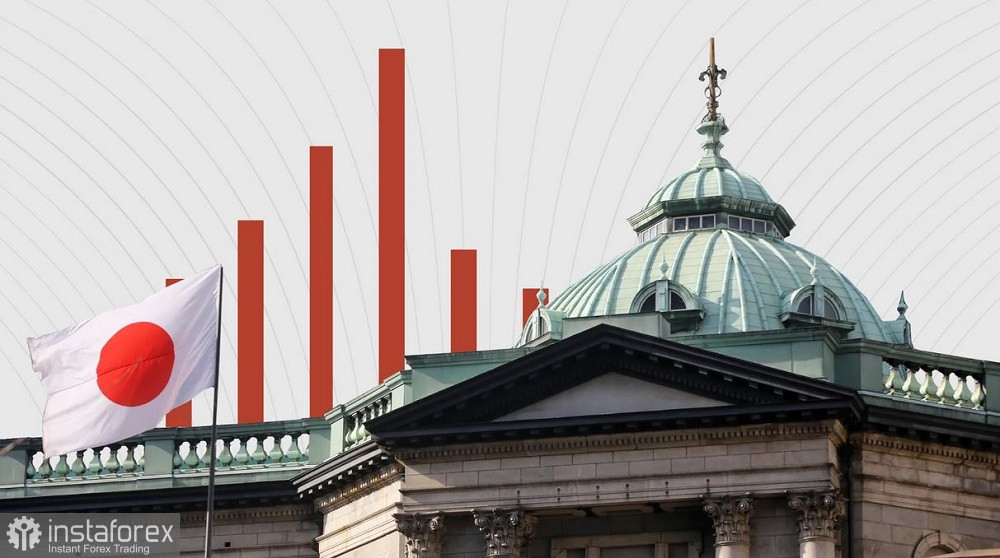The Bank of Japan will announce the results of its meeting on March 19. This is by no means a routine event. Regardless of the outcome, whether the regulator will maintain its policy unchanged or decide to raise the interest rate, there is no consensus in the market regarding the possible results of the March meeting. Therefore, any outcome will inevitably trigger increased volatility for the USD/JPY pair. The question is only in whose favor – buyers or sellers.
First of all, it is worth noting that the Japanese currency has recently been actively losing its positions: throughout last week, the USD/JPY pair demonstrated an upward trend. Last Monday, the price was at the level of 146.50, while today, the pair is testing the resistance level at 149.40 (the middle line of the Bollinger Bands indicator on the daily chart). The price increase was preceded by an equally sharp 400-point decline.
Traders were reacting to the preliminary results of "shunto" (annual negotiations between employers and trade unions on wage increases). More precisely, this was only one stage of the negotiation process – with the largest corporations. Major Japanese companies have decided to increase salaries for their employees by an average of more than 4% – against the backdrop of labor shortages and a significant increase in the cost of living. The results of these negotiations indicate that the Bank of Japan may well take a step towards normalizing monetary policy for the first time in 17 years.

Furthermore, it has now become known that Japan's largest national trade union, RENGO (which includes 54 member unions and 47 local organizations), has announced that average wages this year will increase by an average of 5.30% – the largest wage increase in over 30 years. For comparison, last year, this union reported a much more modest result (+3.8%).
Amid such results, rumors/speculations/forecasts have emerged that the Japanese regulator may begin to normalize its policy as early as March. In particular, such a forecast was voiced by currency strategists at Goldman Sachs. In their opinion, at the moment, the Bank of Japan has enough arguments to change its monetary policy – the central bank members do not need to wait for the quarterly economic outlook report (which is published in April) to justify a change in monetary policy.
However, not everyone agrees with such a hawkish forecast. And judging by the behavior of the USD/JPY pair, traders are mostly skeptical about the prospects of a rate hike this month. For example, analysts at UBS Group, on the one hand, noted the quite strong results of negotiations with major corporations. On the other hand, they reminded that the impact of "shunto" on small and medium-sized companies will become apparent only after the second and third rounds of negotiations, scheduled for March 22 and April 4, respectively.
According to experts, the second round is the most significant because it covers more than half of the total number of companies. All this suggests that the Bank of Japan is unlikely to rush to make a decision and will wait at least until April when the information picture will be more complete.
In favor of a wait-and-see position are also the recent statements of Bank of Japan Governor Kazuo Ueda, which were quite cautious in nature. According to him, the regulator will seek to exit from the policy of negative interest rates, YCC, and other large-scale easing measures only when inflation reaches "2% stably and sustainably." Ueda also pointed out sluggish consumer spending. According to the latest data, consumer spending in October–December decreased by 0.3% compared to the previous three months.
Thus, the intrigue regarding the outcome of the Bank of Japan's March meeting remains. There are many arguments in favor of a wait-and-see position, however, "hawkish" assumptions are also not baseless (strong "shunto" negotiations being the main argument).
In my opinion, the Bank of Japan will still maintain the status quo, and Ueda will reiterate the messages already voiced that the regulator needs more information to make a decision.
Another important point. There is a possibility that the Central Bank will announce a "dovish" rate hike – by 10 basis points, that is, to zero, without announcing further steps in this direction. According to some analysts, the Bank will keep the rate at 0.0% at least until the end of the first quarter of 2025. If the Japanese regulator does announce such a gradual tightening of monetary policy, the yen will come under strong pressure despite the de facto implementation of a hawkish scenario.
Given the high degree of uncertainty, it is prudent to maintain a wait-and-see position on the USD/JPY pair. The outcome of the March meeting could strengthen the yen, but it could also sink it, which is quite likely.





















